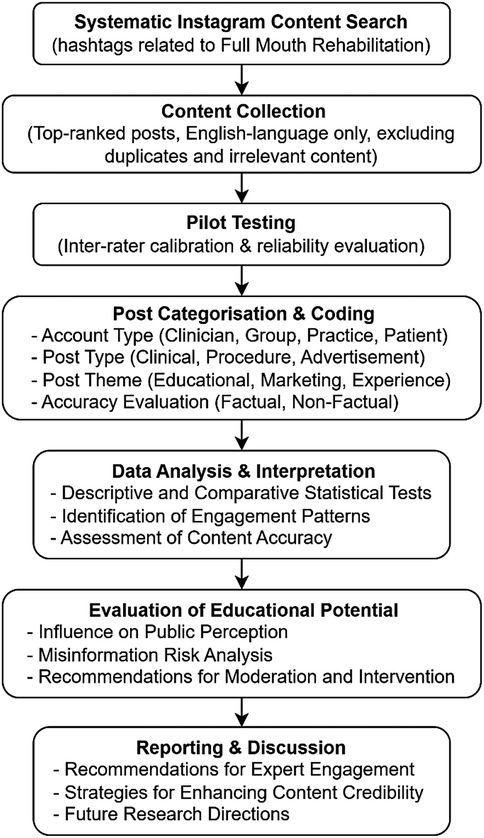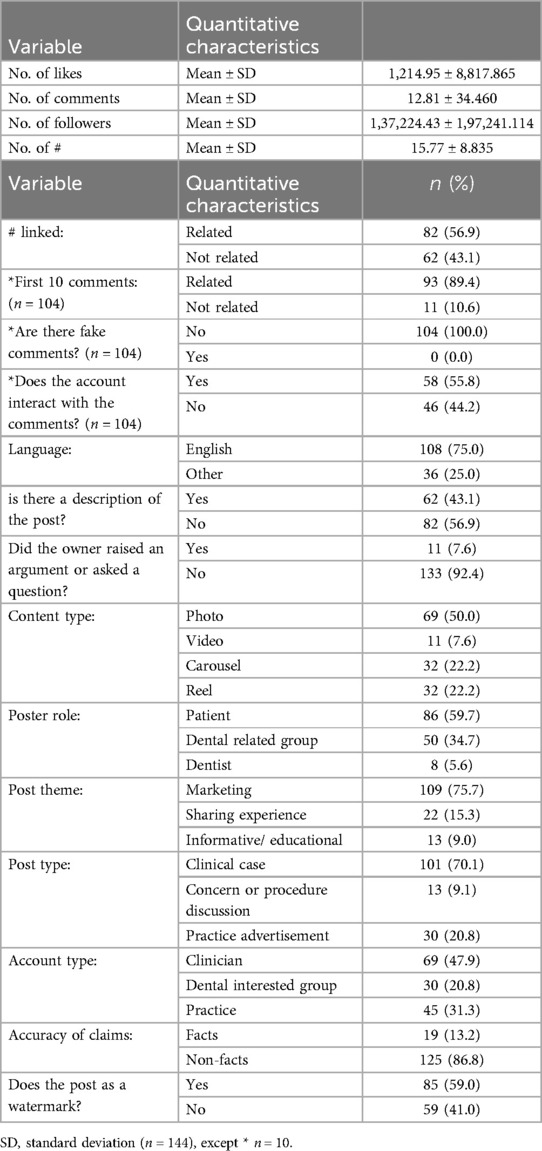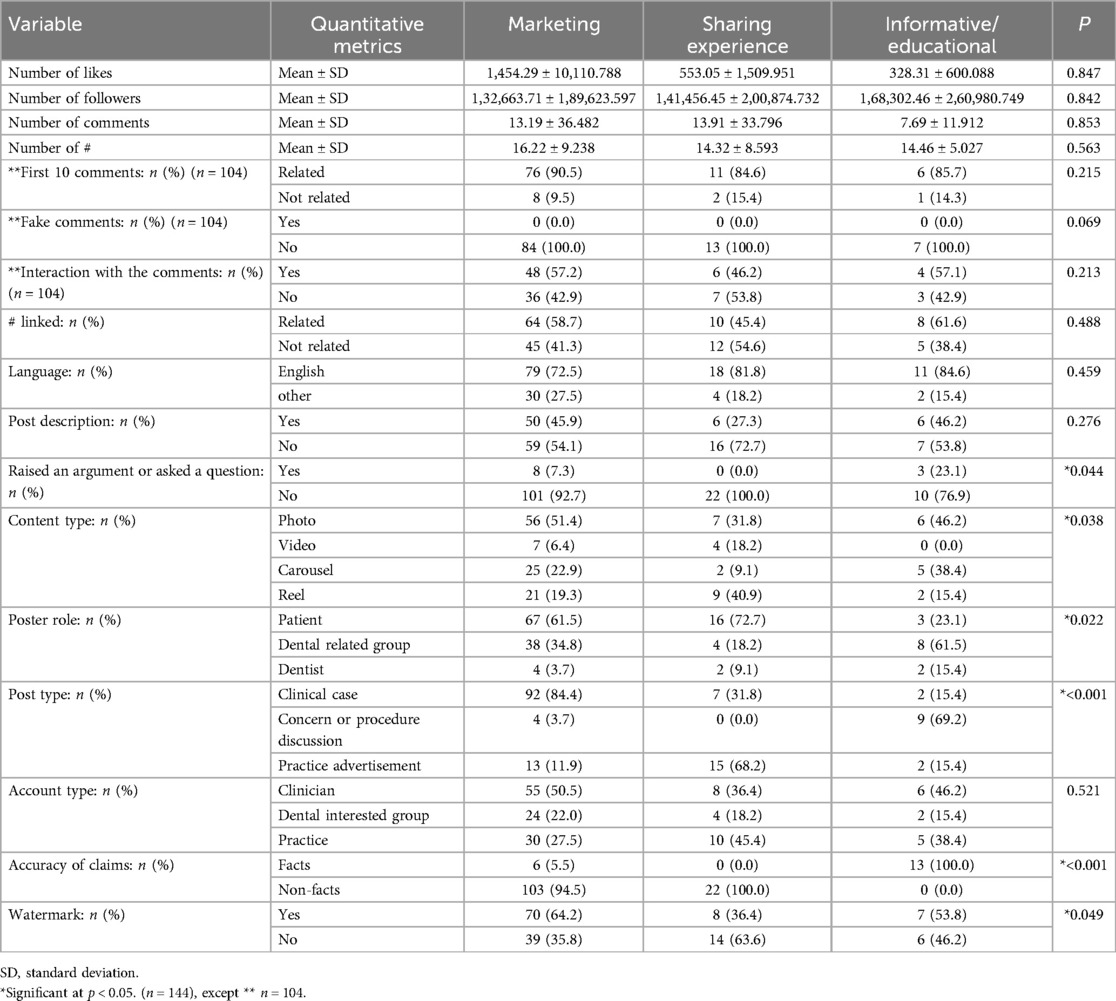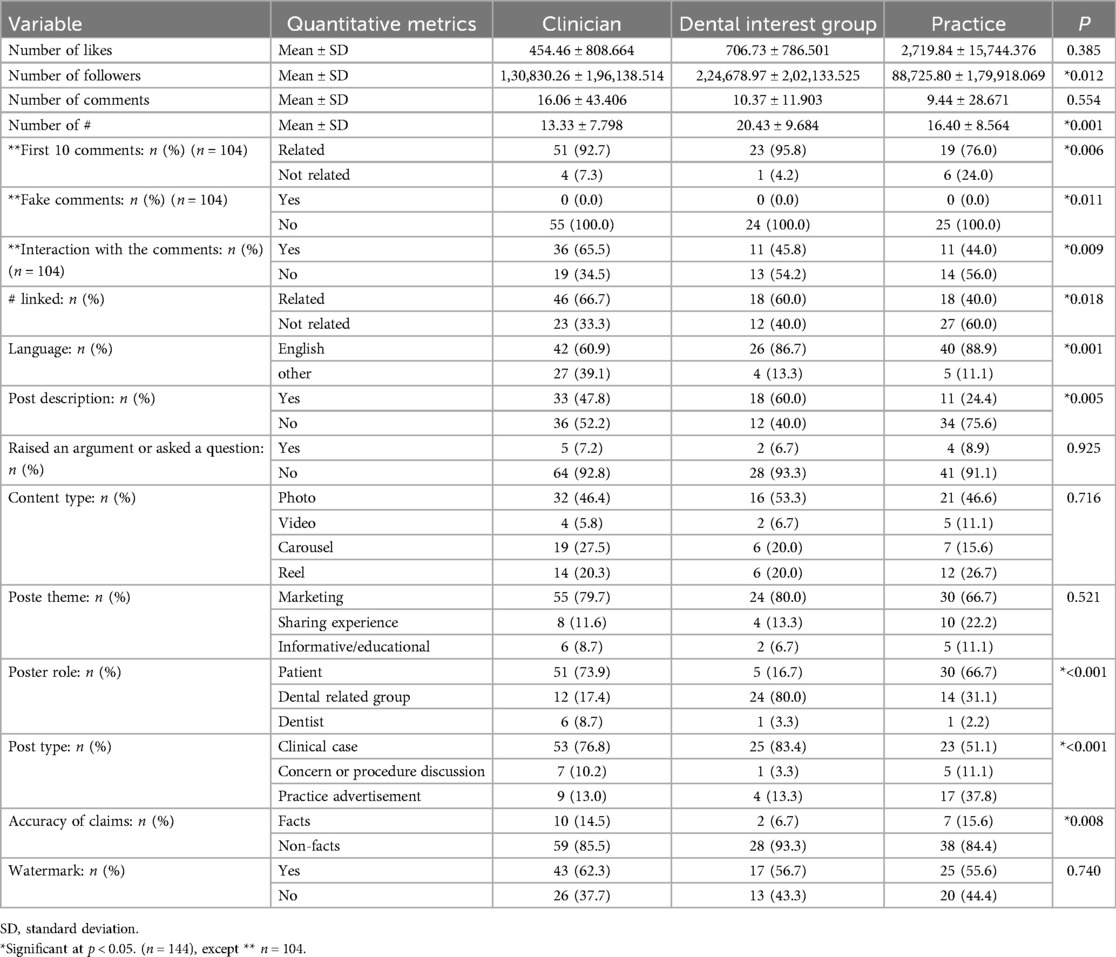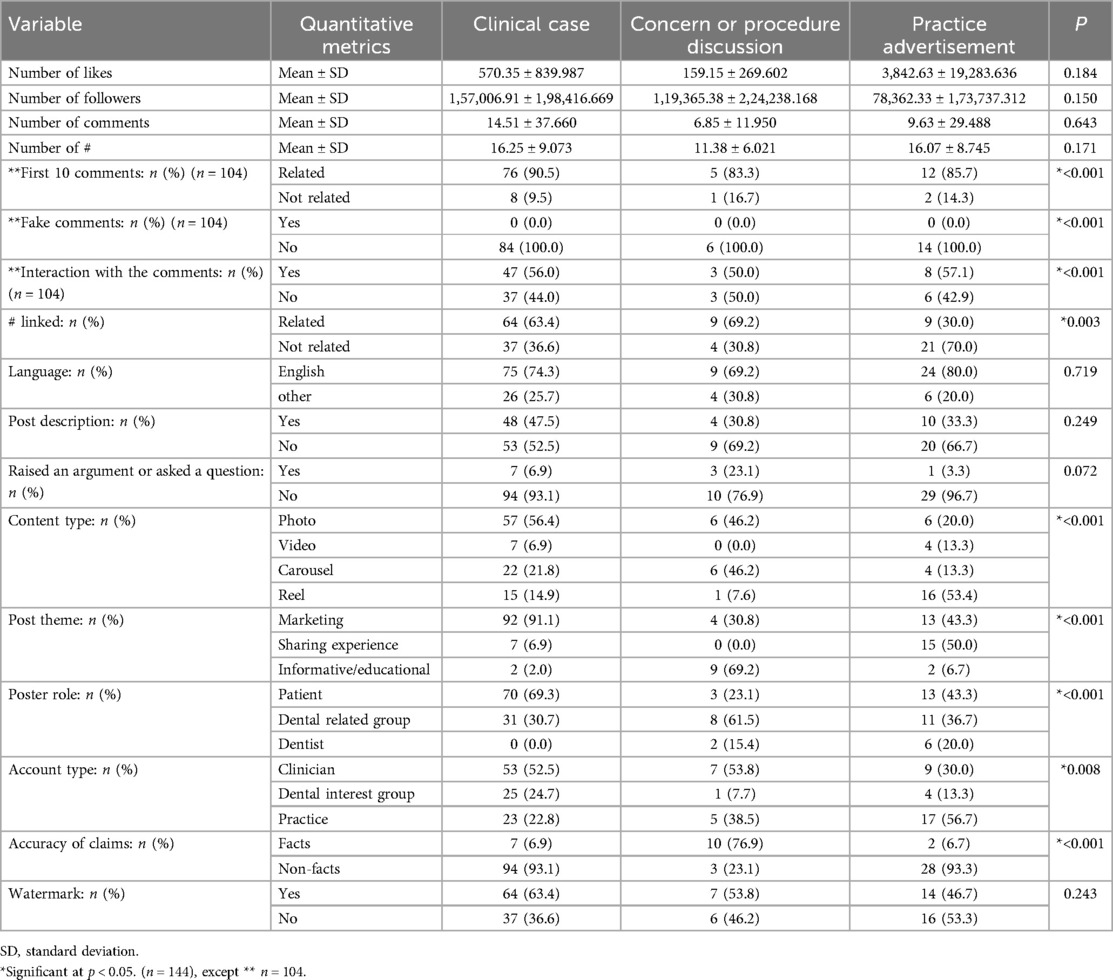- 1Department of Prosthodontics and Dental Implantology, College of Dentistry, King Faisal University, Al-Ahsa, Saudi Arabia
- 2Department of Substitutive Dental Sciences, College of Dentistry, Imam Abdulrahman Bin Faisal University, Dammam, Saudi Arabia
- 3College of Dentistry, Imam Abdulrahman Bin Faisal University, Dammam, Saudi Arabia
- 4Department of Substitutive Dental Science, College of Dentistry, Taibah University, Madinah, Saudi Arabia
- 5Department of Preventive Dental Sciences, College of Dentistry, Imam Abdulrahman Bin Faisal University, Dammam, Saudi Arabia
Introduction: Social media platforms have become pivotal in health communication, with Instagram serving as a key channel for sharing medical and dental information. Full Mouth Rehabilitation (FMR), a complex treatment aimed at restoring oral function and aesthetics, remains underrecognized by the general public. This study investigates the nature and accuracy of Instagram content related to FMR.
Methods: A cross-sectional content analysis was conducted on 144 Instagram posts using FMR-related hashtags. Posts were classified based on content type, poster role (e.g., dental professional, clinic, influencer), engagement metrics (likes, comments), and accuracy of information. Statistical tests were applied to assess variations across content categories.
Results: Marketing-oriented content constituted the majority of posts (75.7%), while educational content accounted for only 9%. Most posts (86.8%) contained non-factual or misleading information. In contrast, all educational posts were factually accurate. Engagement levels did not significantly differ between factual and non-factual posts. Dental professionals were responsible for only 5.6% of the total content, reflecting a notable lack of expert presence.
Discussion: Instagram holds significant potential for disseminating accurate dental health information. However, the dominance of promotional content and the low involvement of dental professionals contribute to a high prevalence of misinformation. To enhance the platform's reliability as a health communication tool, increased participation by dental experts and improved content oversight are essential. Future research should evaluate strategies for promoting evidence-based information on social media, particularly for advanced procedures like FMR.
Introduction
Full Mouth Rehabilitation (FMR) is a comprehensive dental treatment aimed at restoring oral function, aesthetics, and overall oral health for patients with complex dental conditions, such as extensive tooth wear, edentulism, or malocclusion (1). This transformative approach often requires a multidisciplinary team that integrates expertise from prosthodontics, orthodontics, periodontics, oral surgery, and other specialties, depending on the complexity of each case (2). FMR not only resolves functional impairments and aesthetic concerns but also contributes to long-term oral health and improved self-confidence, making it a cornerstone of advanced dental care (3).
Despite its clinical benefits, public awareness of FMR remains limited. Several barriers, such as the high cost of treatment, limited availability of specialists, and misinformation about advanced dental procedures, restrict its broader adoption (4). A growing body of research indicates that social media platforms, particularly Instagram, play an increasing role in shaping public perceptions of healthcare services, including dentistry (5). However, while these platforms serve as valuable educational tools, they also pose risks of spreading misleading or promotional content that may not always align with evidence-based dental practices.
Social media, particularly Instagram, has emerged as a dominant force in digital health communication (6). With its visually driven format and algorithmic content promotion, Instagram enables dental professionals to showcase FMR outcomes, engage with patients, and contribute to public health education (5). However, social media algorithms prioritize engagement metrics such as likes, shares, and comments, often amplifying promotional content over factual educational materials (7). This creates an environment where commercial interests may overshadow accurate health communication, potentially influencing patient decision-making based on incomplete or misleading information.
Recent studies have highlighted the proliferation of health misinformation on social media, particularly within cosmetic and elective medical fields, including dentistry (8). The accessibility of user-generated content has led to a diversification of voices in digital health communication, yet professional oversight and accuracy verification remain limited. Despite increasing patient reliance on Instagram for healthcare information, dental professionals remain underrepresented in digital discourse, limiting the availability of expert-driven, evidence-based content.
Given the growing impact of social media on healthcare education, it is critical to evaluate the role of Instagram in disseminating FMR-related information. This study aimed to describe the characteristics and assess the informational accuracy of Instagram posts related to Full Mouth Rehabilitation (e.g., clinicians, dental practices, influencers). A key research question is whether Instagram serves as an effective public health communication tool for FMR or if misinformation and commercial promotion undermine its educational potential. The hypothesis suggests that while Instagram provides a platform for information-sharing, its content quality and reliability vary significantly, potentially affecting public perception and decision-making regarding FMR treatment.
Methods
Given the increasing reliance on Instagram as a source of health information, this study sought to evaluate the role of social media in shaping public perceptions and potential misinformation regarding FMR. The study design is illustrated in Figure 1.
The study focused on English-language content and was based on a systematic search of Instagram posts tagged with relevant hashtags. The methodology, including data collection and analysis, was adapted from prior research on social media trends in healthcare (9, 10). Hashtags were selected based on their popularity, relevance to FMR, and engagement metrics on Instagram. The final set of 12 hashtags included the following hashtags: #fullmouthrehabilitation, #oralrehabilitation, #fullmouthreconstruction, #fullmouthrehab, #fullmouthrestoration, #mouthrehabilitation, #fullmouthrejuvenation, #mouthreconstruction, #fullmouthrestorations, #oralreconstruction, #Oralrehab and #mouthrehab.
To standardize data collection and minimize algorithmic bias, a pilot test was conducted using a small sample of posts. Discrepancies in categorization were resolved through discussion and consensus among researchers to ensure uniform evaluation criteria. Two coders conducted a pilot test by coding 50 random posts related to dental smile alterations and FMR. A weighted Kappa was utilized to test the reliability. Both coders classified another 50 randomly selected posts and were reclassified one week after the first coding. The weighted Kappa was 0.775 for inter-agreement and 0.820 and 0.720 for intra-agreement (two coders) with an overall excellent reliability. Any conflict in coding was resolved by a gold standard examiner via discussion to ensure full understanding of post categorization.
Data were collected on a single day to control for Instagram's dynamic content ranking system, which prioritizes engagement metrics such as likes, shares, and comments. For each hashtag, the top 12 ranked posts were retrieved following Instagram's search and discovery algorithm. Posts deemed irrelevant or duplicate were excluded.
Data extraction and coding
Each post was categorized based on the following variables: Account type (identified as a dental practice, dental professional, dental laboratory, influencer, or commercial entity), post type (classified into clinical procedure, practice advertisement, product promotion, or patient experience), poster role (differentiated as a dental organization, company, patient, or licensed dentist), post theme (categorized as educational, marketing, or experience sharing), posts were further classified based on intent (educational vs. promotional) and content format (image, video, reel, or carousel). Engagement metrics, including likes, comments, follower counts, and hashtags used, were recorded for each post.
Accuracy of claims and misinformation identification
To assess the accuracy of claims, posts were evaluated using a binary classification scale (factual vs. non-factual). This was adapted from previous methodologies in health misinformation research (10). A post was classified as factual if its content aligned with peer-reviewed literature, clinical guidelines, or professional dental sources. Non-factual claims included misleading statements, exaggerated treatment outcomes, or incorrect procedural descriptions.
To ensure reliability and minimize evaluator bias, data coding was conducted independently by two trained researchers. A calibration process was implemented during the pilot phase to establish coding consistency, reducing inter-evaluator variability.
Statistical analysis
Descriptive statistics, including means, standard deviations, frequencies, and percentages, were used to summarize data distributions. Normality testing using the Shapiro–Wilk test indicated that the data were not normally distributed, necessitating the use of non-parametric statistical methods.
The Mann–Whitney U test was employed for comparisons between two groups (e.g., educational vs. promotional posts). While the Kruskal–Wallis test was applied for comparisons across multiple groups (e.g., account types, post themes). Furthermore, pairwise comparisons were adjusted using the Bonferroni method to reduce the likelihood of Type I errors. In addition, categorical variables (e.g., accuracy of claims) were analyzed using the chi-square test, with Monte Carlo corrections applied when cell counts were below five. All statistical analyses were performed using IBM SPSS Statistics (version 22.0), with a significance threshold of p < 0.05.
Ethical considerations
This study adhered to ethical guidelines for digital research and the analysis of publicly available social media content. As all posts were publicly accessible, no direct interaction with users occurred, and no identifiable private data were collected. Given that the study did not involve human participants, institutional review board (IRB) approval was not required. However, ethical best practices for social media research were followed, including transparency in methodology and adherence to data privacy guidelines.
Results
Background characteristics of Instagram posts
Table 1 presents the general characteristics of 144 Instagram posts related to Full Mouth Rehabilitation (FMR). Photos were the most common content format (50%), followed by reels and carousels (22.2% each), and videos (7.6%). Most posts were in English (75%), and 56.9% lacked a written description.
The average number of likes per post was 1,214.95 (±8,817.87), with 12.81 (±34.46) comments and a mean follower count of 137,224.43 (±197,241.11). Among posts that received comments (n = 104), 89.4% of the first 10 comments were related to the content, with no fake comments identified. Account interaction with commenters was observed in 55.8% of cases.
Patients posted the majority of content (59.7%), followed by dental-related groups (34.7%) and dentists (5.6%). Most posts were marketing in nature (75.7%), while only 9% were categorized as educational. In terms of the accuracy of the information, 86.8% of posts contained non-factual claims—such as unrealistic promises of “permanent whitening with FMR” or “instant bite correction”—while all educational posts were factually accurate. Watermarks were found in 59.0% of posts.
Post themes
Table 2 shows post characteristics categorized by theme: marketing, experience sharing, and educational. While marketing posts had the highest average number of likes, the differences across themes were not statistically significant. Educational posts had the highest average follower count, while experience-sharing posts received the most comments.
A significant difference was found in the accuracy of the information (p < 0.001): 100% of educational posts were factual, whereas 94.5% of marketing and all experience-sharing posts included non-factual content. Watermark presence also varied significantly (p = 0.049), being more frequent in marketing posts.
Account types
Table 3 summarizes post characteristics based on the type of account: clinician, dental interest group, or dental practice. Although practices had the highest average number of likes, this was not statistically significant. Dental interest groups had significantly higher follower counts (p = 0.012) and used more hashtags (p = 0.001). Clinicians were more likely to interact with comments and use relevant hashtags.
Significant differences were also observed in language use and content description. Clinician accounts posted more frequently in languages other than English, while dental interest group posts were most likely to include descriptions. Accuracy of information varied (p = 0.008), with factual content appearing slightly more often in clinician and practice posts.
Post types
Table 4 outlines characteristics based on post type: clinical cases, procedure discussions, and advertisements. Clinical case posts were the most interactive, receiving the highest number of comments and follower engagement, though differences were not statistically significant. However, they were also the least factual—93.1% contained misleading or exaggerated claims.
In contrast, procedure discussion posts had the highest proportion of accurate information (76.9%). Content type differed significantly by post type (p < 0.001), with photos dominating clinical cases and reels being most common in advertisements. Themes also varied significantly, with marketing posts dominating clinical cases and educational content concentrated in procedure discussions.
Discussion
This study analyzed Instagram posts related to Full Mouth Rehabilitation (FMR) to assess content characteristics and informational accuracy. While Instagram has potential as a tool for public dental communication, the findings revealed considerable variability in content quality, notably dominated by promotional and non-factual posts. This indicates a prioritization of visibility over veracity in health-related social media content, potentially skewing public perceptions regarding advanced dental treatments. A recent systematic review similarly identified widespread misinformation across various health domains, including dentistry, highlighting that nearly 29% of content could be inaccurate or misleading (11).
Only 9% of posts analyzed in this study were educational; however, these consistently aligned with professional standards and contained accurate information. Conversely, 94.5% of promotional posts presented exaggerated or misleading claims, such as “instant smile correction” or “permanent results in a single session,” potentially leading to unrealistic patient expectations. These findings support earlier research indicating that visually appealing but factually questionable content typically gains higher engagement compared to accurate educational material, likely due to emotional appeal and simplicity (12, 13). Despite these risks, promotional content can beneficially increase awareness by visually demonstrating potential outcomes, thus enhancing user understanding of what specific treatments entail and fostering informed curiosity when appropriately moderated. and stimulate public interest in dental procedures by visually showcasing potential aesthetic improvements. To balance engagement with accuracy, promotional materials must incorporate clear disclaimers and contextual information.
The predominance of misinformation emphasizes the ethical implications of social media usage in healthcare, especially when clinical information lacks appropriate qualifications or context. Posts devoid of clinical disclaimers can influence patients toward complex procedures based on superficial visuals rather than informed decisions, underscoring the urgent need for increased transparency, rigorous content moderation, and active professional participation.
Moreover, licensed dental professionals contributed only 5.6% of FMR-related posts, significantly limiting the availability of expert-driven narratives and potentially exacerbating misinformation. Engel et al. (14) noted that patient-generated content often lacks crucial clinical context, leading to the unchecked spread of inaccurate information. Bratland et al. (15) further highlighted concerns regarding anecdotal, non-expert-driven discourse dominating digital health spaces. Although social media presents significant opportunities for healthcare professionals to educate the public, various barriers—including limited time, inadequate digital training, and concerns about maintaining professionalism—often impede their active engagement (5, 16). Addressing these barriers through targeted digital literacy programs and institutional support could encourage dental professionals' proactive participation, significantly improving the credibility and educational quality of online dental health information.
Instagram's inherently visual format greatly enhances user engagement, presenting significant opportunities to promote dental treatments such as FMR effectively. Nevertheless, the prevalent use of before-and-after images can oversimplify complex treatments and lead to unrealistic expectations, particularly when such visuals lack detailed explanations. Thapliyal et al. (17) and Ghahramani et al. (18) have stressed that while Instagram can effectively raise dental health awareness, the absence of expert moderation and structured information substantially diminishes its educational effectiveness. Applying communication theories, such as the Elaboration Likelihood Model (ELM); for example, using visually engaging before-and-after images coupled with comprehensive explanatory captions to encourage deeper audience reflection, can enhance our understanding of these dynamics. ELM posits that while visually attractive promotional content engages users through peripheral cues, educational content that encourages deeper cognitive processing results in better knowledge retention (19).
Engagement metrics further complicate the misinformation landscape, underscoring the need for algorithmic adjustments that prioritize accuracy and reliability over popularity, alongside educational strategies such as digital literacy training programs that teach users to critically evaluate health-related content. on Instagram, as algorithms prioritize content popularity over accuracy, inadvertently amplifying misinformation spread. High engagement with misleading content thus reinforces its visibility and perceived legitimacy. To mitigate these effects, algorithmic moderation mechanisms and educational initiatives aimed at developing users' critical appraisal skills are vital. Such interventions can empower users to discern and evaluate dental health information critically, promoting informed decision-making.
This study has certain limitations, including its cross-sectional design and restriction to English-language posts, potentially limiting content diversity. Future research should explore longitudinal designs, incorporate multilingual content, and directly assess user perceptions to comprehensively understand how Instagram influences public perceptions and decision-making regarding dental treatments. Additionally, examining digital literacy interventions could provide practical insights into reducing susceptibility to misinformation.
Enhancing the credibility of FMR-related content on Instagram requires coordinated efforts among dental professionals, academic institutions, and social media platforms. Recommended strategies include supporting dental professionals to produce engaging, evidence-based content, adjusting algorithms to prioritize accurate health information, implementing robust fact-checking systems, and promoting public digital literacy programs. Such comprehensive initiatives are critical for improving the quality and reliability of oral health communication via social media.
Conclusion
While Instagram can serve as an educational platform, its current landscape is dominated by promotional content, much of which lacks factual accuracy. Educational posts, though limited in number, were consistently reliable, highlighting the importance of expert participation in online dental communication. Strengthening digital health literacy and promoting evidence-based content are essential steps toward making Instagram a credible resource for advanced dental information.
Data availability statement
The original contributions presented in the study are included in the article/Supplementary Material, further inquiries can be directed to the corresponding author.
Ethics statement
This study adhered to ethical guidelines for digital research and the analysis of publicly available social media content. As all posts were publicly accessible, no direct interaction with users occurred, and no identifiable private data were collected. Given that the study did not involve human participants, institutional review board (IRB) approval was not required. However, ethical best practices for social media research were followed, including transparency in methodology and adherence to data privacy guidelines.
Author contributions
AmA: Conceptualization, Data curation, Formal analysis, Funding acquisition, Investigation, Methodology, Project administration, Supervision, Validation, Writing – original draft, Writing – review & editing. FA: Conceptualization, Supervision, Visualization, Writing – original draft, Writing – review & editing. MeA: Data curation, Formal analysis, Investigation, Methodology, Writing – original draft, Writing – review & editing. NA: Data curation, Formal analysis, Investigation, Methodology, Writing – original draft, Writing – review & editing. MoA: Data curation, Formal analysis, Investigation, Methodology, Writing – original draft, Writing – review & editing. AlA: Writing – original draft, Writing – review & editing. SA: Writing – original draft, Writing – review & editing. KA-K: Conceptualization, Data curation, Formal analysis, Investigation, Methodology, Project administration, Supervision, Validation, Visualization, Writing – original draft, Writing – review & editing.
Funding
The author(s) declare that no financial support was received for the research and/or publication of this article.
Conflict of interest
The authors declare that the research was conducted in the absence of any commercial or financial relationships that could be construed as a potential conflict of interest.
Generative AI statement
The author(s) declare that Generative AI was used in the creation of this manuscript. Artificial intelligence tools (ChatGPT, OpenAI, 2025 version) were used to support the writing and editing of this manuscript, particularly in refining language clarity, improving coherence, and structuring academic sections such as the introduction and discussion. All content was reviewed, validated, and approved by the authors to ensure accuracy, originality, and alignment with the study’s findings.
Publisher's note
All claims expressed in this article are solely those of the authors and do not necessarily represent those of their affiliated organizations, or those of the publisher, the editors and the reviewers. Any product that may be evaluated in this article, or claim that may be made by its manufacturer, is not guaranteed or endorsed by the publisher.
References
1. Bhat S, Shetty S. Full mouth rehabilitation of a patient with severe tooth wear. J Indian Prosthodont Soc. (2014) 14(Suppl 1):283–7. doi: 10.4103/0972-4052.138993
2. Patel N, Moss D, Tahmaseb A, Torabinejad M. The multidisciplinary team approach to full mouth rehabilitation. J Am Dent Assoc. (2018) 149(10):859–65. doi: 10.1016/j.adaj.2018.05.001
3. Tan K, Pjetursson BE, Lang NP, Chan ES. A systematic review of the survival and complication rates of fixed partial dentures (FPDs) after an observation period of at least 5 years. Clin Oral Implants Res. (2004) 15(6):667–76. doi: 10.1111/j.1600-0501.2004.01119.x
4. Gribble J, Ayers C, Wiseman J. The psychological impact of full mouth rehabilitation using dental implants. J Dent. (2019) 85:1–6. doi: 10.1016/j.jdent.2019.04.008
5. Ventola CL. Social media and health care professionals: benefits, risks, and best practices. Pharm Ther. (2014) 39(7):491–520.
6. Baiju RM, Peter E, Varghese NO, Rani S. Access to full mouth rehabilitation services in India: a nationwide study. J Indian Prosthodont Soc. (2021) 21(1):38–45. doi: 10.4103/jips.jips_312_20
7. Gerritsen AE, Allen PF, Witter DJ, Bronkhorst EM, Creugers NH. Tooth loss and oral health-related quality of life: a systematic review and meta-analysis. Health Qual Life Outcomes. (2010) 8:126. doi: 10.1186/1477-7525-8-126
8. Gupta A, Shreshtha B, Jachak A, Khatana S, Rajkumar E. Full mouth rehabilitation: a case report. J Pharm Bioallied Sci. (2015) 7(Suppl 2):S783–6. doi: 10.4103/0975-7406.163474
9. Al-Khalifa KS, AlSheikh R, Alakloby BO, Alharbi HM, Alghamdi RF, Ali S, et al. Instagram’s impact on dental consumers: analyzing toothpaste hashtags. Front Oral Health. (2025) 5:1420500. doi: 10.3389/froh.2024.1420500
10. Ellakany P, Aly NM, Hassan MG. #Implantology: a content analysis of the implant-related hashtags on Instagram. J Prosthet Dent. (2023). doi: 10.1016/j.prosdent.2023.10.013
11. Suarez-Lledo V, Alvarez-Galvez J. Prevalence of health misinformation on social media: systematic review. J Med Internet Res. (2021) 23(1):e17187. doi: 10.2196/17187
12. Menezes TS, Jucá AM, Jorge OS, Lotto M, Ayala Aguirre PE, Cruvinel T. Unraveling dental caries misinformation: identifying predictive factors for engagement on Instagram. Digit Health. (2024) 10:20552076241299642. doi: 10.1177/20552076241299642
13. Alkadhimi A, Al-Moghrabi D, Fleming PS. The nature and accuracy of Instagram posts concerning marketed orthodontic products: a cross-sectional analysis. Prog Orthod. (2022) 23(1):1–8. doi: 10.1186/s40510-021-00385-1
14. Engel E, Gell S, Heiss R, Karsay K. Social media influencers and adolescents’ health: a scoping review of the research field. Soc Sci Med. (2024) 340:116387. doi: 10.1016/j.socscimed.2023.116387
15. Bratland KM, Wien C, Sandanger TM. Exploring online health information seeking behaviour (OHISB) among young adults: a scoping review protocol. BMJ Open. (2024) 14(1):e074894. doi: 10.1136/bmjopen-2023-074894
16. Van Ravenswaay L, Parnes A, Nisly SA. Clicks for credit: an analysis of healthcare professionals’ social media use and potential for continuing professional development activities. Med Educ Online. (2024) 29(1):2316489. doi: 10.1080/10872981.2024.2316489
17. Thapliyal K, Thapliyal M, Thapliyal D. Social media and health communication: a review of advantages, challenges, and best practices. In: Garcia M, de Almeida R, editors. Emerging Technologies for Health Literacy and Medical Practice. Hershey, PA: IGI Global Scientific Publishing (2024). p. 364–4. doi: 10.4018/979-8-3693-1214-8.ch017
18. Ghahramani A, de Courten M, Prokofieva M. The potential of social media in health promotion beyond creating awareness: an integrative review. In: Garcia M, de Almeida R, editors. BMC Public Health. (2022) 22(1):2402. doi: 10.1186/s12889-022-14885-0
Keywords: full mouth rehabilitation, Instagram health education, digital misinformation, social media dentistry, public engagement
Citation: Alfaraj A, Alshahrani FA, Albalawi M, AlQahtani N, Alhajji M, Alharbi AS, Ainoosah S and Al-Khalifa KS (2025) Misinformation or education? A comparative analysis of Instagram posts related to full mouth rehabilitation. Front. Dent. Med. 6:1585575. doi: 10.3389/fdmed.2025.1585575
Received: 28 February 2025; Accepted: 7 July 2025;
Published: 24 July 2025.
Edited by:
Naseer Ahmed, Altamash Institute of Dental Medicone, PakistanReviewed by:
Constanza E. Fernández, University of Talca, ChileNatalino Lourenço Neto, University of São Paulo, Brazil
Copyright: © 2025 Alfaraj, Alshahrani, Albalawi, AlQahtani, Alhajji, Alharbi, Ainoosah and Al-Khalifa. This is an open-access article distributed under the terms of the Creative Commons Attribution License (CC BY). The use, distribution or reproduction in other forums is permitted, provided the original author(s) and the copyright owner(s) are credited and that the original publication in this journal is cited, in accordance with accepted academic practice. No use, distribution or reproduction is permitted which does not comply with these terms.
*Correspondence: Khalifa S. Al-Khalifa, a2Fsa2hhbGlmYUBpYXUuZWR1LnNh
 Amal Alfaraj
Amal Alfaraj Faris A. Alshahrani
Faris A. Alshahrani Meshal Albalawi
Meshal Albalawi Naif AlQahtani
Naif AlQahtani Mohammed Alhajji3
Mohammed Alhajji3 Khalifa S. Al-Khalifa
Khalifa S. Al-Khalifa